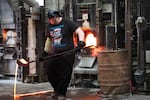Oregon health officials have concluded a years-long assessment of a glass manufacturer that polluted a Southeast Portland neighborhood with toxic metals.
The Oregon Health Authority released its final public health assessment of Bullseye Glass Company, located in Portland’s Brooklyn neighborhood, on Monday. The agency concluded it doesn’t have enough information about air conditions surrounding the company prior to 2016 to say whether long-term exposure harmed people’s health. Even so, the report says the agency found high enough levels in October 2015 that long-term exposure could have led to harmful health effects, like bladder cancer, had those levels persisted.
The Oregon Department of Environmental Quality first became aware of air pollution surrounding the company between 2013 and 2015, when it paired up with the U.S. Forest Service to test tree moss from around Portland for toxins. Those initial tests showed high levels of cadmium and other metals around Bullseye and another glass manufacturer, Uroboros Glass in North Portland. Both had been using heavy metals like cadmium and arsenic to color glass for sculptures, stained-glass art, dishware and architecture.

Bullseye Glass makes artistic and architectural colored glass in Southeast Portland.
Cassandra Profita, OPB / EarthFix
The Bullseye Glass property near Southeast Powell Boulevard and Southeast 21st Avenue takes up a city block. It’s within a half mile of schools, homes, a public park and a daycare center.
In response to those results, DEQ installed air monitors around Bullseye to test for pollutants in October 2015. It released preliminary results the following year. Those results were so alarming to nearby residents, reads OHA’s final assessment, that they asked if they should consider moving out of the area. Community groups formed around air quality concerns and organized to speak at public meetings, where people expressed distrust in government agencies and called on officials to take action.
The Oregon Health Authority in 2016 launched a public health assessment using the October 2015 air monitoring data. The final report says people who breathed the air during that one month likely didn’t get exposed to harmful levels of air pollutants. However, had the company not taken measures to reduce its pollution the following year, then people could have been harmed by long-term health effects. Bullseye stopped using cadmium, arsenic and chromium to color glass in 2016.
State regulators also say produce grown in the area is likely safe since most garden produce doesn’t absorb metals like arsenic and cadmium. OHA recommends people follow standard urban gardening practices, including washing hands after gardening, taking off shoes to avoid tracking soil inside and washing homegrown produce before eating it.
In response to public concern in 2016, OHA reimbursed the cost of cadmium urine testing for people living near Bullseye Glass and Uroboros Glass, though the agency didn’t recommend the testing. The agency says those test results have “too many uncertainties and scientific limitations to draw a health conclusion” because it didn’t pursue a systematic way of collecting urine samples, like by recruiting a randomized sample of the population. OHA says there wasn’t a “statistically significant” increase in bladder cancer or lung cancer rates in the three census tracts around Bullseye Glass from 1999 to 2013.
